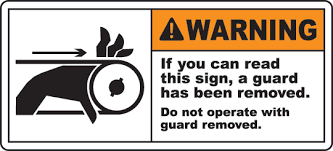Written by Lori Amerman, IMEC Operations Coordinator
Hazards of machinery can cause catastrophic injuries when employees come in contact. Crushing and amputations are devastating to the employee’s quality of life. The employer is faced with many costs of medical expenses, equipment fixes and training. According to OSHA’s $afety Pays Program, an amputation on average has a direct cost of $77,995 and indirect of $85,794. At a 3% profit margin assumption these costs would require an additional $2,859,816 in sales to recover.
 Compliance
Compliance
Machine guarding ranks in the top 5 OSHA standards cited across manufacturing industries in FY17. Recognizing the severity of this type of hazard and injury, OSHA has a national emphasis program for amputation prevention. This program prescribes how the compliance officer is to conduct a focused inspection in specific industries with higher hazard equipment. For assistance improving your workplace, see the Amputations publication.
Management
The most important resource to recognize and control the hazard is management practices. Establish a baseline of guarding for existing equipment, along with a plan for potential upgrades. Budget time and monetary resources to not only maintain but improve. Ensure staff routinely audit for the hazards and employees are trained. Never permit or encourage bypassing safety procedures or equipment to save time. Employee involvement in the safety program is essential. No one understands the job better than the person doing it.
Maintenance
An effective maintenance program is an essential tool in protecting against machine hazards. Maintenance staff should ALWAYS be taught and expected to follow safe work practices such as adhering to machine specific lockout procedures. Equipment is only profitable when it is running. Injuries are more likely to happen and be severe if equipment is run until there is a catastrophic failure. Schedule and prioritize equipment maintenance to at least the standard of manufacturer recommendations.
Training
Train to NEVER bypass guards. Train to stay out of the point of operation. Train to report problems. Train on first aid and emergency response procedures.
Moving machine parts have the potential to cause severe workplace injuries, such as crushed fingers or hands, amputations, burns, or blindness. Safeguards are essential for protecting workers from these preventable injuries. Any machine part, function, or process that may cause injury must be safeguarded. When the operation of a machine or accidental contact injure the operator or others in the vicinity, the hazards must be eliminated or controlled.
- Prevent contact - prevent worker’s body or clothing from contacting hazardous moving parts
- Secure - firmly secure guards to machine and ensure they’re not easily removed
- Protect from falling objects - ensure that no objects can fall into moving parts
- Create no new hazards - must not have shear points, jagged edges or unfinished surfaces
- Create no interference - must not prevent worker from performing the job quickly and comfortably
- Allow safe lubrication - if possible, be able to lubricate the machine without removing the safeguards
To learn more and hear from regional resources in the field, mark your calendar for January 22, 2018 for SIOSH / SAFETYCON at Southern Illinois University Edwardsville. The conference will feature a machine guarding session presented by Aaron Priddy, OSHA Area Director for Fairview Heights, Illinois.
The following additional resources will help you review your current programs and evaluate the need for improvement.
OSHA provides the following guidance:
https://www.osha.gov/SLTC/machineguarding/index.html
Machine Guarding eTool
https://www.osha.gov/SLTC/etools/machineguarding/index.html
$afety Pays Program
https://www.osha.gov/shpguidelines/safety-pays.html
National Emphasis Program on Amputations
https://www.osha.gov/enforcement/directives/nep
Amputations: Safeguarding Equipment and Protecting Employees from Amputations
https://www.osha.gov/Publications/osha3170.pdf




